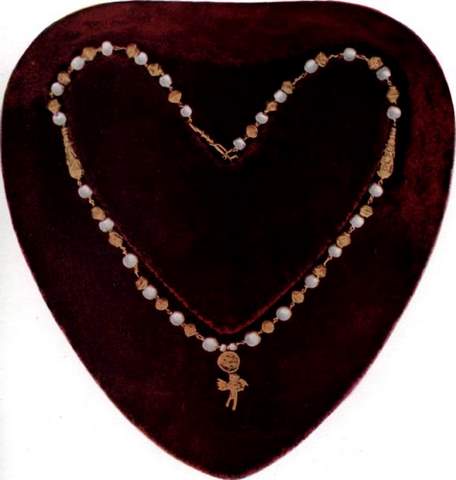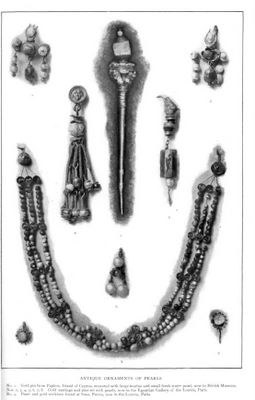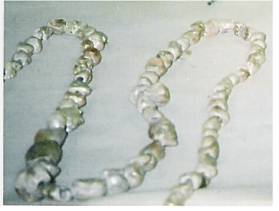|
Antique PearlsLearn about antique pearls from antiquity from Kunz & Stevenson. Not many pearls have survived the many centuries of pillage, waste, and burial in the earth.
 Antique Pearl Necklace in Louvre Since most of this information was written in 1908, locations of items mentioned may have changed.
A number of specimens of pearls of the artistic Greeks and of the luxurious Romans are yet in existence, and some of these are in a fairly good state of preservation. A notable and interesting example is a superb Greek necklace of pearls and gold, referred to the third century B.C., and now in the Metropolitan Museum of Art in New York.  Grecian Pearl & Gold Necklace Several earrings now in that museum, in the hermitage at St. Petersburg, the British Museum, the Louvre in Paris, and in the Boston Museum of Fine Arts. Some of these may have decorated ears that listened to the comedies of Aristophanes, the tragedies of Euripides, the philosophies of Plato, or the oratory of Demosthenes. A number of classic statues have the ears pierced for earrings, notable the Venus de Medici now in the Tribuna of the Uffizi, Florence; and a magnificent pair of half-pearls is said to have decorated the Venus of the Pantheon in Rome.
Pearl grape earrings are shown on the artistic intaglio by ASpasios, representing the bust of the Athene Parthenos of Phidias, which has been in the Gemmen Munzen Cabinet at Vienna since 1669.
The beautiful Tyszkiewicz bronze statuette of Aphrodite was acquired in 1900 by the Boston Museum of Fine Arts, and has even yet a pearl in a fairly good state of preservation suspended from each ear by a spiral thread of gold which passes quite through the gem and also through the lobe of the ear. This statuette has been described as "the most beautiful bronze Venus known." Professor Froehner considers that it belongs nearer to the period of Phidias (circa 400-336 B.C.); but Dr. Edward Robinson does not concur in this opinion, and refers it to the Hellenic period (circa 330-146 B.C.).  Susa & Other Antique Pearls However, considering the very large accumulations relatively few pearls of antiquity now remain, and none of these is of great ornamental value. Those in archaeological collection and art museums are more or less decayed through the ravages of time and accident to which they have been subjected. While coins, gold jewelry, crystal gems, etc., of ancient civilizations are relatively numerous, the less durable pearls have not survived the many centuries of pillage, waste, and burial in the earth.
A well known instance of this decay is found in the Stilicho pearls, which owe their prominence to the incident of their long burial. The daughters of this famous Roman general, who were successively betrother to the Emperor Honorius, died in 407 A.D., and were buried with their pearls and ornaments. In 1526, or more than eleven centuries afterward, in excavating for an extension of St. Peter's, the tomb was opened, and the ornaments were found in fair condition, except the pearls, which were as lusterless and dead as a wreath of last year's flowers.  Antique Pearls from Iowa Learn about the antique pearls in the above photo found in an Indian mound in Iowa.

Free Newsletter all about Pearls!
|






